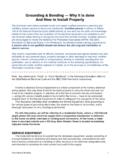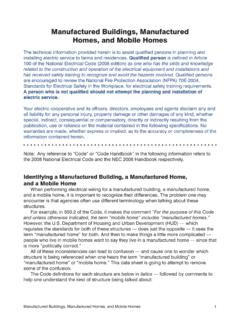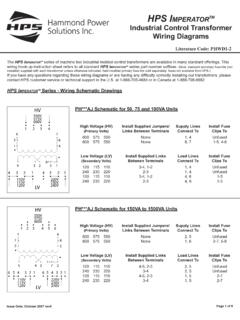Transcription of Voltage Drop - Adams Electric
1 Voltage Drop 1 Voltage DropThe technical information provided herein is to assist qualifi ed persons in planning and installing Electric service to farms and residences. Qualifi ed person is defi ned in Article 100 of the National Electrical Code (2008 edition) as one who has the skills and knowledge related to the construction and operation of the electrical equipment and installations and has received safety training to recognize and avoid the hazards involved. Qualifi ed persons are encouraged to review the National Fire Protection Association (NFPA) 70-2004, Standards for Electrical Safety in the Workplace, for electrical safety training requirements. A person who is are not qualifi ed should not attempt the planning and installation of Electric Electric cooperative and its offi cers, directors, employees and agents disclaim any and all liability for any personal injury, property damage or other damages of any kind, whether special, indirect, consequential or compensatory, directly or indirectly resulting from the publication, use or reliance on the material contained in the following specifi cations.
2 No warranties are made, whether express or implied, as to the accuracy or completeness of the information contained : Any reference to Code or Code Handbook in the following information refers to the 2008 National Electrical Code and the NEC 2008 Handbook respectively. Everyone knows that the consumer is required to pay for the electricity supplied by the Electric cooperative that is measured at the kilowatt-hour meter. But part of that electricity between the meter and the end location where it is to be used will get lost due to a condition called Voltage drop. Voltage drop can be thought of as wasted electricity. It is simply the difference between the Voltage measurement at the source and the Voltage measurement at the point of use.
3 Besides paying for electricity you don t receive, Voltage drop can cause other problems as well. Due to Voltage drop caused by improperly sized circuit conductors, the operating Voltage at electrical equipment will be less than the output Voltage of the power supply. This will result in inductive loads ( motors, ballasts, etc.) operating at voltages below its rating-which in turn can cause them to overheat resulting in shorter equipment operating life and increased cost, as well as inconvenience for the consumer. Under- Voltage for sensitive electronic equipment such as computers, laser printers, copy machines, etc., can cause the equipment to lock up or suddenly power down resulting in data loss, increased cost and possible equipment failure.
4 Resistive loads (heaters, incandescent lighting) that operate at under-voltages simply will not provide the expected rated power output. In the fi ne print notes of Section (A)(1) and (A)(3) of the Code, it recommends that the maximum combined Voltage drop for both the feeder and branch circuit should not exceed 5 percent. If this practice is followed, the Code says that reasonable effi ciency of operation will occur. Knowing this, what s the minimum Code recommended operating Voltage for a load connected to a 120v source? Answer: Since Voltage Drop 2the maximum conductor Voltage drop recommended for both the feeder and branch circuit is fi ve percent of the Voltage source, the total conductor Voltage drop should not exceed ( 120v x 5%) or no more than 6V less than the source.
5 So, the operating Voltage should be no less than ( 120v 6V) or 114V. Reducing Voltage Drop It s not possible to have zero Voltage drop because some Voltage loss is going to occur naturally from the resistance of the conductors themselves simply because it takes effort ( Voltage ) to push current through a conductor. However, the goal is to minimize the Voltage drop as much as possible. Besides wasting electricity that you are paying for, there are other reasons to keep Voltage drop to a minimum when performing electrical wiring. These reasons include: System effi ciency. If a circuit has much of a load, a larger conductor (that allows less Voltage drop) pays for itself many times over in energy savings alone.
6 System performance. As stated before, excessive Voltage drop in a circuit can cause lights to fl icker and/or burn dimly; heaters to heat poorly; and can cause overheating, ineffi ciency, and shorter life span of motors. Troubleshooting. When one follows the Code Voltage drop recommendations, the electrician doing troubleshooting does not have to guess whether his low Voltage fi eld measurements indicate (1) a problem or (2) that Voltage drop was not accounted for in the design. Causes of Voltage drop There are various causes of Voltage drop. One of the main causes is the conductor itself that is being used. The following four factors determine the resistance found in a conductor: Type of Material from which the conductor is made Copper conducts electricity better than aluminum and will cause less Voltage drop than aluminum for a given length and conductor size.
7 Diameter of the Conductor (size or gauge of the conductors) Conductors with larger diameters will result in less Voltage drop than conductors with smaller diameters of the same length. Conductor Length Shorter conductors will have less Voltage drop than longer conductors for the same conductor size. Temperature of the Conductor As a general rule, most conductive materials will increase their resistance with an increase of you consider two more Current being carried by the conductor (Ampere Load) Voltage drop increases on a conductor with an increase in the current fl owing through the conductor. Connections in the circuit Poor connections in splices or when connecting conductors to terminals contribute to Voltage drop.
8 You now have all the primary conditions that cause Voltage drop on a Voltage Drop Since we know that it is necessary to keep Voltage drop to a minimum, sometimes one may fi nd it necessary to compute the Voltage drop of an installation when the length, size Voltage Drop 3of wire, and current of the load are known. The following formulas can be used to fi nd the Voltage drop of an application using either copper or aluminum conductors. For single-phase Drop = 2 x K I L cmil For three-phase Drop = K I L cmil Where K = ohms-cmil per ft I = current (or amperes) of load L = length of conductor in ft.
9 (one-way) cmil = circular mil area of the conductor What is K in the formulas? K is the electrical resistivity of the type of conductor being used. The K value is a constant and can be found in most physics tables that provide resistivity of various materials. This electrical resistivity is calculated by (electrical resistance x cross-sectional area/ longitudinal length) and is expressed as (ohms x cmil/ft) or simply (ohms-cmil/ft.) Copper has a K value of ohms-cmil/ft and aluminum has a K value of ohms-cmil/ft. Other reference materials may show slightly different values, but for the purposes of this discussion, these values are acceptable. These two values are derived from the data found in Chapter 9, Table 8 of the Code.
10 The K factor is found by multiplying the conductor s resistance (ohm/kFT) by the conductor s circular mil area and then dividing by is cmil in the formulas? The circular mil or cmil is a unit of area that s used when denoting the cross sectional size of something circular in shape such as a wire. Wire size can be measured in several ways such as its diameter. We could say this wire has a diameter of inch. Calculating the area of the cross-section with the common formula of Area = r2 or Area = [( )(d/2) 2] would give us [( ) x ( inches/2) 2] for an answer of square inches. As you can see, that is an extremely small number to work with and would be hard to express the wire size to others using this method.








